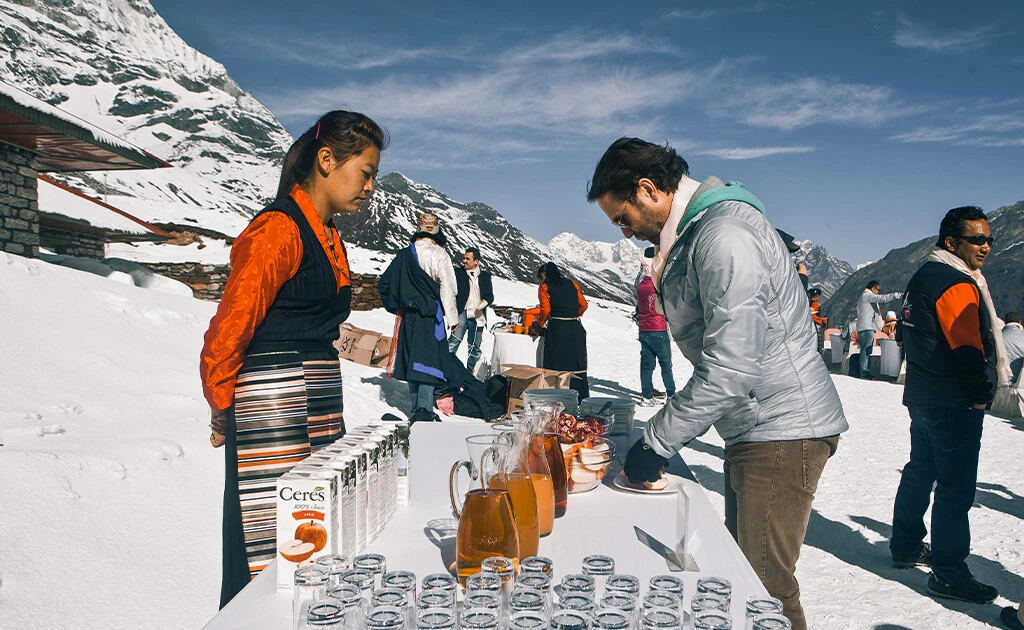Everest View Trek Difficulty
Everest View Trek is an easy to moderate-range trek. This is a beginner-friendly trek that you can do with your family. You'll spend four full days in the mountains hiking on uneven trails. The Everest View trek route ascends through forests and alongside verdant hills. The trail from Phakding village to Namche Bazaar is a bit difficult because the final part involves steep climbing. It is doable and only demands a little extra effort, so you do not have to worry about it. You do not need previous trekking experience to join the Everest view trek. It is a perfect trek for people of all ages. Ensure you are healthy and fit enough to walk 5 to 6 hours daily.
Everest View Trek Route
The Everest view trek route begins with a scenic, short flight from Kathmandu to Lukla. You will descend to Phakding village following the Dudh Koshi River to spend the night. On the way, cross many suspension bridges and walk past small villages. Then you'll walk through Monjo and continue trekking towards Namche Bazaar, crossing a long hanging suspension bridge. Spend a couple of nights in Namche Bazaar.
Go on a hike to Hotel Everest View to witness the very first view of Mt. Everest. The hike continues to Khumjung monastery before you return to Namche Bazaar. The walk will be tiring, but the breathtaking views will make it all worth it. You will then retrace the trail back to Lukla and take another short flight back to Kathmandu, which marks the end of the trek.
Altitude Sickness
Altitude sickness, or acute mountain sickness risk is very low during the Everest View Trek. The highest altitude gain during the trek is 3,962 meters. From Kathmandu at 1,400 meters, you will fly to Lukla at 2,860 meters. This part of the venture carries a high risk of altitude sickness, therefore we spend the night in Phakding village at 2,610 meters. It will give you a high elevation gain and sleep-low advantage and let your body acclimatize, lowering the potential threat of altitude sickness. Then you spend another two nights in Namche Bazaar, hiking to a high point and returning to the village to spend the night. Our trek guide help you in case you see any symptoms like difficulty in breathing, insomnia, vomiting, loss of appetite, headache, etc. Keep yourself hydrated, and do not drink alcoholic drinks while trekking. Smoking will also dehydrate your body, so stay away from it.
Best Season
Spring (March to April) and autumn (October to November) are the best time for Everest view trekking. The Lukla flights are operate on time if the weather remains stable, and the climate mild. Please note that Lukla Airport is one of the most dangerous high-altitude airport in the world. the weather may affect the flight schedule, so please think for one or two spare days. You do not have to face any weather hurdles in spring and autumn, which makes these two seasons the peak time to trek in the Himalayas. The mountain views are phenomenal and clear. Hundreds of trekkers hit the trail, making the surroundings vibrant and lovely.
Accommodation & Meals During The Trek
You stay overnight in a lodge during the Everest view trek. The lodge will be decent, with twin-shared rooms and private/common washrooms. The rooms will be small but have ample space to move around. You will get a comfortable mattress and blanket to spend the night. There is no heating system in the rooms in the normal lodges. The dining area is the warmest part of the lodge, where you can spend time.
Our Everest view trek cost covers three meals, breakfast, lunch & dinner. All the meals are provided as per the menu. Dal bhat is a must to have at least one meal. You will get all the energy and nutrients. Other items, such as pizza, roti, curries, burgers, sandwiches, momo, noodles, thukpa, porridge, soup, bread, bakery items, eggs, steak, mashed potatoes, oats, etc. are available too.
Internet, Charging, & ATM On The Trail
Lodges along the Everest View trail offer paid WiFi service. The connection may get disturbed from time to time because of elevation & weather. The WiFi is not as fast as in the cities, but it'll keep you connected. Normally most tea houses charge some box for wifi. The better alternative is to buy a Nepali tourist sim and get data to use during the trek. Paid charging stations are available in the lodges. There are no charging slots in the rooms. You can charge your device at the charging stations built around the reception or dining area. Carry spare batteries or a power bank for more convenience. There is an ATM in Namche Bazaar where you can withdraw Nepali money. Namche Bazaar has many souvenir shops and cafes where you can buy things. For easy management, you must keep some Nepali rupees for your expenses.
Travel Insurance
Travelling to Nepal for trekking is amazing, but be prepared for risks. Travel insurance isn't required but is highly recommended. Your insurance should cover medical costs and emergency evacuations, with a minimum of USD 100,000. The Himalayas are beautiful but dangerous, with risks like altitude sickness and accidents. Buy a plan that includes helicopter rescues, as they are the only way to evacuate in emergencies. Proof of insurance is needed for these services. Having good travel insurance ensures a safer and more enjoyable trek in Nepal.
Everest View Trek Solo
With the new rule, all trekkers must have a licensed trekking guide. We highly recommend trekking with a guide for a more meaningful journey. Guides ensure your safety and provide valuable insights about all regions of Nepal and their local cultures. Our guides are reliable, friendly, and fluent in English, so there will be no communication issues.
To get more information please visit the following link Latest Travel Updates
